I’ve written countless times about khachapuri. This cheese bread is featured in each of my Georgian restaurant reviews at least once, if not more, and it appears on the menus of many Russian restaurants too. I’ve posted my Adjaran version, but I’ve never posted an Imeretian khachapuri, the simplest kind, which consists of a round bread stuffed with cheese. Many would consider it to be Georgia’s national dish
The reason why I’ve waited so long is that I wanted it to be really good. I’m sure I’ve read most of the khachapuri recipes ever published, and I’ve tried a good dozen different formulas. I also had to make my own cheese, which took yet more time to perfect; I’ve posted my takes on Imeretian cheese and sulguni recently.
Nothing’s ever really perfect, but the state I’ve reached satisfies me for now. Before I change my mind and decide to do a few more batches to find more details to improve upon, let’s talk about various criteria of a good Imeretian khachapuri…
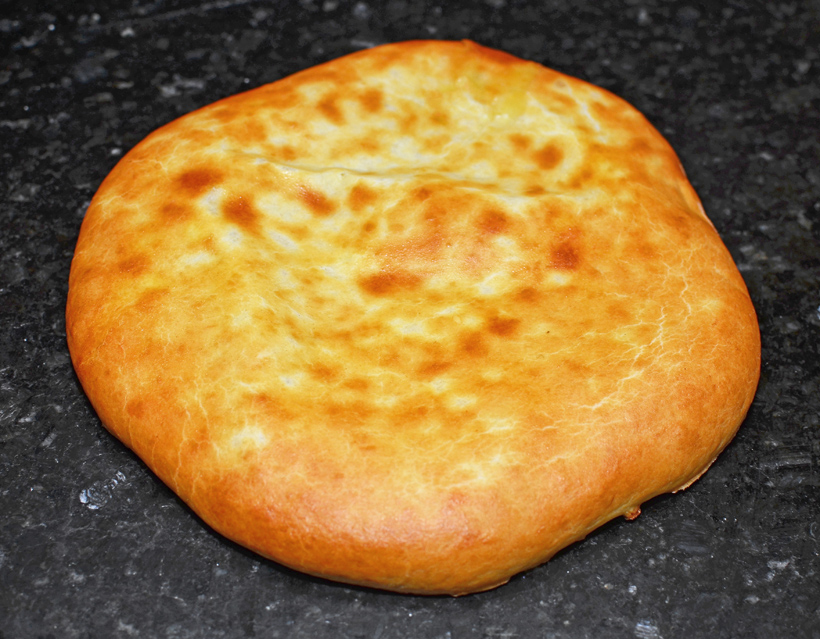
- According to Tinatin Mjavanadze’s Georgia with Taste, the cheese should be only Imeretian, so that the khachapuri still tastes good when you eat the leftovers cold. A bread made with sulguni would have the texture of cold pizza, and many people don’t like that. I’m not a supporter of leftover bread, but the goal is still commendable. I’ve made sure my khachapuri’s still great when eaten cold, although I’ve found I can achieve this while still using some percentage of sulguni.
- In the Cookbook of the Soviet Peoples, khachapuri is described as a baked good “with high cheese content”. Pokhlebkin suggests a cheese-to-flour ratio by weight around 2:1, and my formula’s pretty close to that — I use slightly more cheese, even! Yes, it does take an awful lot of cheese to make a khachapuri. I’ve “discarded” (read: forced myself and my family to eat) countless versions that were too doughy.
- Since it’s such a staple, there’s the idea that one should be able to prepare khachapuri quickly if need be. My recipe is indeed quite easy, with a yeast-free dough that contains matsoni (Georgian yogurt), another must-have ingredient. You don’t really have to make your own cheese; a blend of feta and mozzarella works quite well (more on this another time).
- As far as I’m concerned, a good khachapuri should reach what I call the fat saturation point, both in the dough and the cheese mixture. Add more butter to the dough, and it will become too soft. Add more cheese, and you’ll start seeing drops of grease in your cooked khachapuri. The proportions below strike just the right balance.
Yeast-free dough
Yields 2 khachapuri of 9″ diameter
5 oz plain whole milk yogurt
1 1/2 eggs
11 oz AP flour, sifted
1/2 tsp salt
2 tsp baking powder
3.5 oz butter, soft
- Place the yogurt and eggs in the bowl of an electric mixer fit with the paddle attachment. Add about 2/3 of the flour with the salt and baking powder, and mix over medium speed until homogeneous.
- Add the butter and the rest of the flour, and mix again.
- Remove the bowl from the mixer, and knead the dough by hand for about one minute. Cover with plastic wrap, and refrigerate for 30 minutes.
Assembly
Yields 1 khachapuri of 9″ diameter
6 oz Imeretian cheese
6 oz sulguni
black pepper, ground
salt
about 10.5 oz dough
1 egg yolk
1 oz water
- Preheat the oven to 450 F, and place a dish full of water on the bottom rack.
- Slice the Imeretian cheese and sulguni. In a bowl, crumble both cheeses between your fingers. Season with black pepper, and adjust the salt level if necessary — the mixture should taste quite salty, but still be edible! I use an extra 1/4 tsp with my homemade cheeses.
- On a floured surface, roll the dough to an 11″ diameter disc (the shape doesn’t need to be perfect at this point). If you’re a perfectionist, make the edges a bit thinner. Place the cheese mixture in the center.
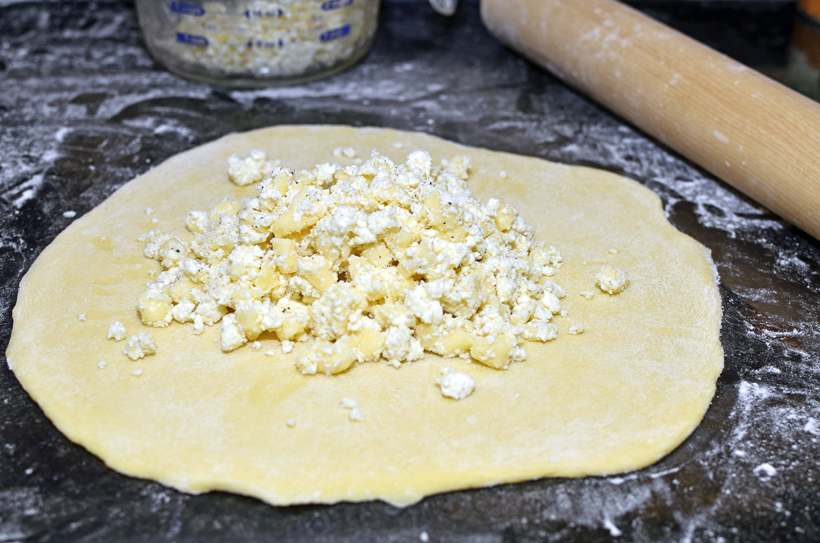
- Fold the dough over the cheese, just like you would wrap something in a hankerchief. Make sure the overlaps are minimal, otherwise you will end up with some very doughy areas.
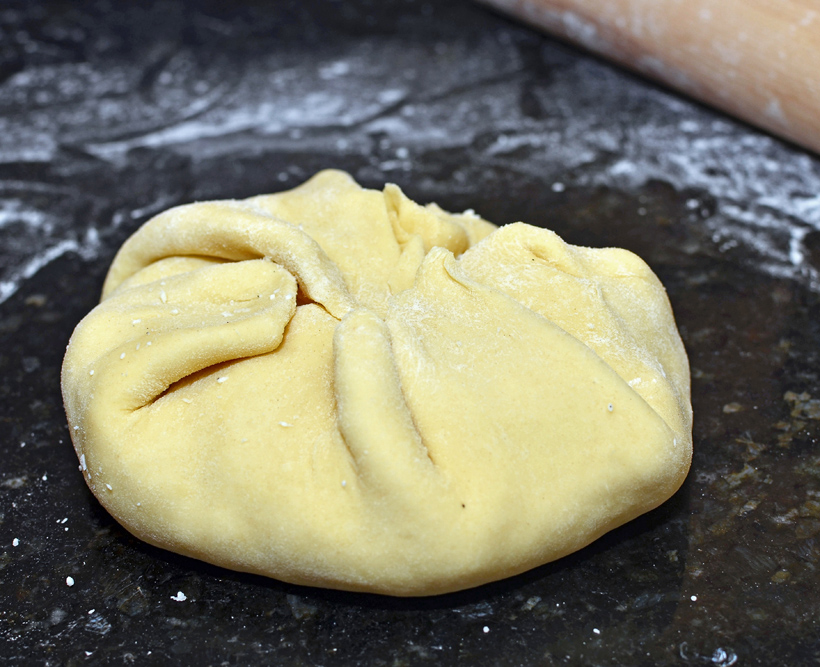
- Flip over, and gently roll back to an 9″ diameter disc.
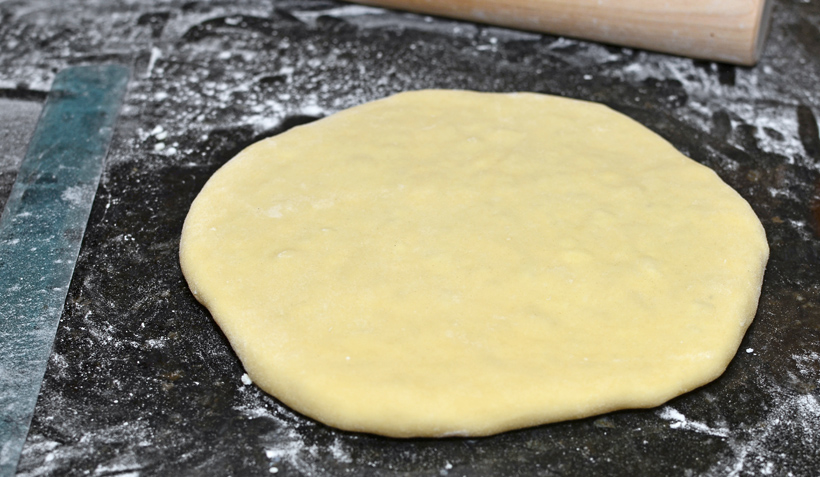
- Transfer the khachapuri to a baking sheet lined with a Silpat or parchment paper. Mix the egg yolk and water in a cup, and brush the dough with the resulting egg wash.
- Bake in the oven for 18-20 minutes, until the top is golden brown. Let cool 5 minutes, then serve.

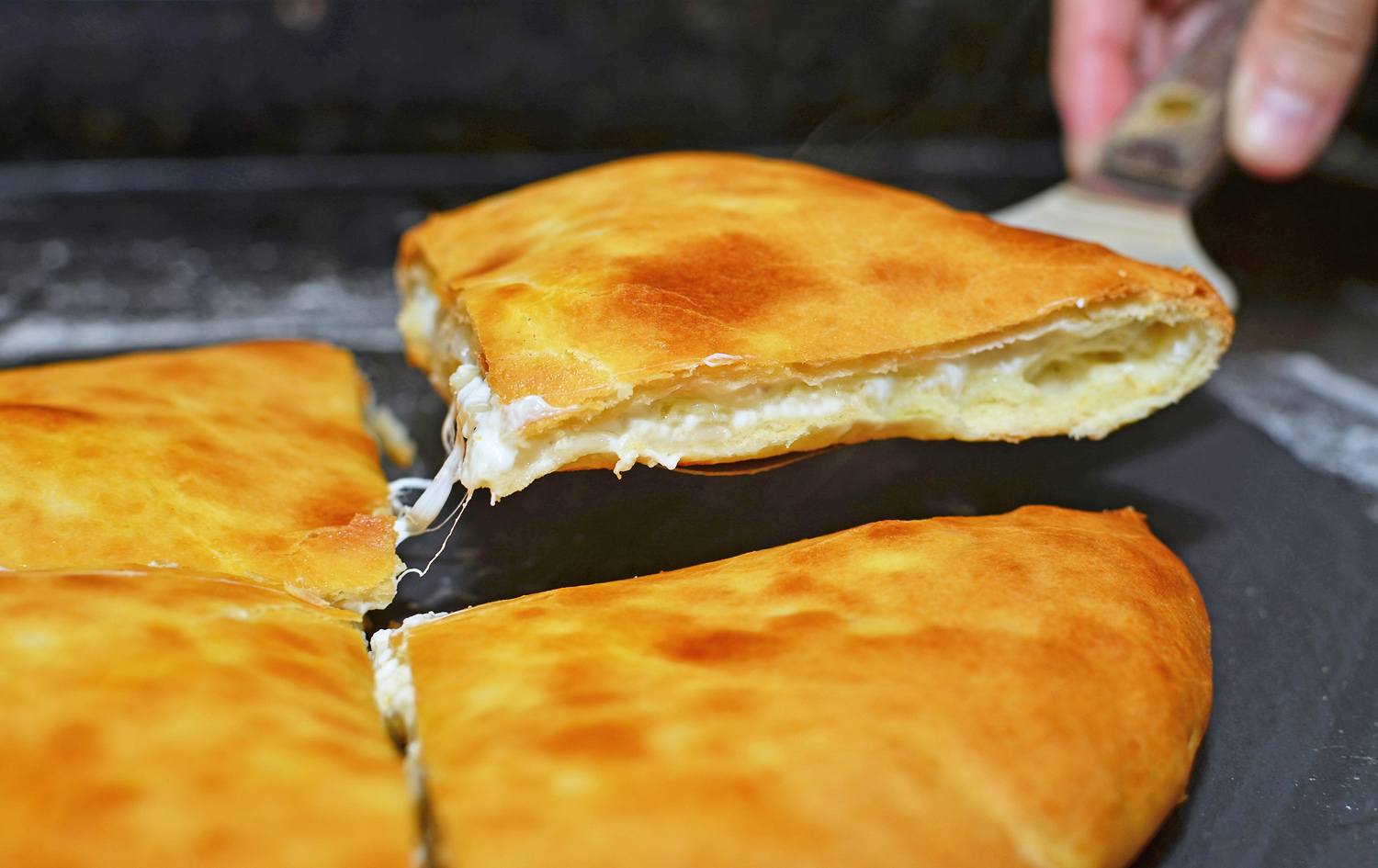
25 comments
Wonderful recipe! Since we don’t have any Imeratian here in Greece, what could we use to substitute? We know it’s one of the main ingredients, but it’s impossible to find it…Can we use white cheese (feta-like, made from cow’s milk)?
Hi, you can use a mix of feta and fresh mozzarella instead.
Thank you Florian! Have a great day!
[…] ones.) I will most definitely be attempting to make the khachapuri at home, likely using this recipe that I found on Food Perestroika, a really cool blog dedicated to Eastern Bloc food. (And […]
Hi! Thanks for this recipe! Just to check… the flour mixture is for two khachapuris, but the cheese recipe is for one? So if I want to make two, I should double the cheese?
That’s right, double the recipe for the cheese mixture if you want 2 khachapuris.
Thank you very much!
Hello! I’m excited to try this bread recipe in the oven this time. I have made this before, but it was on the stovetop from a different recipe. I was a little thrown off by the measurements that were in ounces. I converted them into TBL and cups in U.S system. I hope it will turn out right by doing that!!
Hello Florian,
I,have a pizza stone. Can. Use it for this recipe. Also, what temperature?
Thank you,
Sona
Hi Sona, you can use a pizza stone, sure! I would keep the same temperature, 450 F.
Thanks Florian, I am trying today. I have friends coming over tonight. I am Armenian Lebanese who lives in Montreal for 25 years but lived in Armenia for 3 years during the 80′ s. My guest is from Oseti, Georgia and another one from gyumri, Armenia. I am making both Armenian and Georgian food. Looking forward to try your amazing recipes. Your blog is Awesome. Thanks a lot. Sona
You’re welcome, and good luck with the dinner!
I’ve tried a number of recipes. This one is by far the best. I find 450 way too hot. You risk it exploding. 350 takes a couple of minutes longer and it comes out the same without bursting
Hi Florian 🙂
Most other Khachapuri recipes I saw online used yeast. I was wondering if your use of baking powder is to make the process faster, or if it is the way it is traditionally made. Regardless, I’ll definitely try your imeretian cheese recipe and this one! Thank you!
Hi Pinkmanta, I think it depends on the type of khachapuri. For an Adjaran khachapuri, I definitely use yeast dough. But in the Imeretian khachapuri, where the dough doesn’t need to rise very much, I think baking powder (or baking soda) works just fine. It’s a dish that Georgians make at home all the time, and baking powder works faster than yeast.
Thank you so much for the prompt reply! I am just waiting for the rennet to come so that I can make the cheese and the khachapuri! 🙂 I also wanted to tell you how much I’m loving your website, and the thoughtfulness put in the research and recipes!
Hi Florian, love the blog btw! Would you recommend regular plain flour or bread flour? I’m making the cheese today to make the Khachapuri later in the week. Thanks!
Hi Charlotte, for this recipe I used regular flour. I’ll update the ingredient list to mention it.
Thank you!
I made this and it was great. My rolling wasn’t ideal, but my dad said it was the best bread he’d ever had and it wasn’t a million miles away from what I had in Kutaisi. I’ll definitely try it again! Thanks!
Thanks for putting this thought info together.
I have sulguni but can’t find imeretian cheese.
Does this mean I should combine sulguni and feta,
Or does it mean sulguni + mozzarella + feta?
Hi Ross, good question… I would try sulguni + mozzarella + feta!
Thanks for adding this! Could you advise if oz you use are weight or volume?
Hi Marina, all the ounces I’m using are weights.
since i have no access to regional cheeses i had to make do with what is available in my corner of the world: mozzarella mixed with cottage cheese. i am sure i am missing on the authentic taste but this dish was still delicious and the recipe worked perfectly well.
thank you very much.